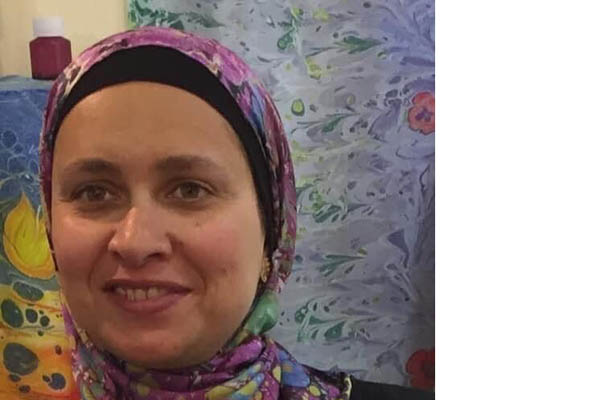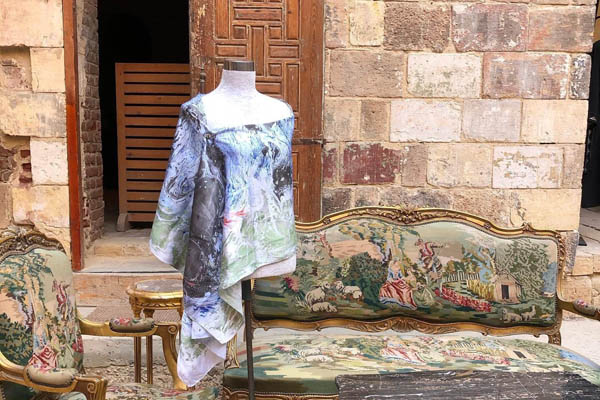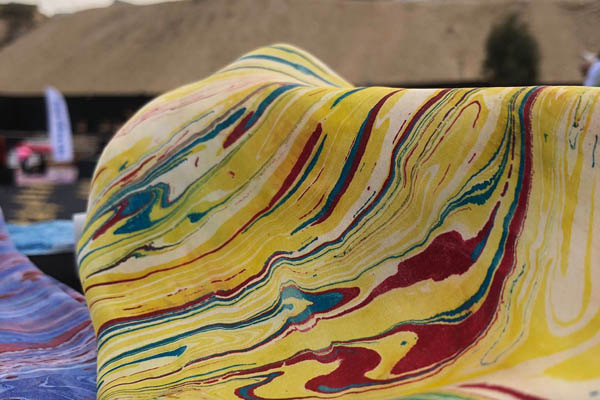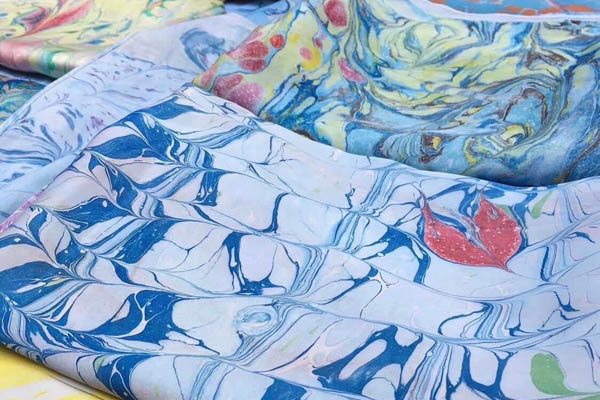Egyptian artist Rasha Morgan’s attempts to apply the traditional technique of marbling on organic cotton has gone hand in hand with her success in producing the largest piece of marbling ever made in Egypt. It measures 50 metres by 3 metres, and the aim is to enter it for the Guinness Book of Records.
The main obstacle to producing the piece was finding a place big enough to work, Morgan said.

“I am grateful to the officials at the Exhibition Centre in Nasr City who offered us a place to produce the piece. We started experimenting on a 10-metre and then a 20-metre piece. Finally, we went for the 50-metre project,” she added.
“It did not succeed the first time. After more experimenting, we managed to produce it on a second attempt in October last year.”
She has sent the Guinness Book pictures and information and is now awaiting their response.

Morgan is an Egyptian artist who took her Master’s degree in arts education in 2012 and her PhD in textile printing in 2021. She has managed to integrate art into her research and is keen to apply marbling techniques on fabrics.
She first came across the art of marbling at the AUC Rare Books Library in Cairo, as it was traditionally used for book covers because the colours helped to ward off bookworms and other pests and ensure that the books would last longer.
The oldest piece of marbling dates back to the 12th century and is now in a museum in China, Morgan said. One of the most famous pieces in Egypt is in the Museum of Islamic Art in Cairo and consists of a cover of the Quran bearing the name of the Mameluke Sultan Jaqmaq in the 15th century.

The National Archives, the Dar Al-Kutub also has a section on marbling art.
Marbling was used during the Ottoman Empire to produce watermarks on official letters to ensure their authenticity.
“The art was very famous in Turkey. Only four families knew the secret of marbling in the 17th century, and death was the punishment for any member of those families who dared to disclose the secrets,” Morgan said.
“The Ottomans also introduced more colours and patterns. Traditionally, marbling was limited in the number of colours used, mostly black and red.”

Known as ebru in Turkey, marbling is the art of creating colourful patterns by sprinkling colours onto a pan of specially treated water and then transferring the resulting patterns onto paper. Various tools are used to sprinkle the colours, including brushes, awls, and combs, as well as blowing through a straw.
Removing the paper from the pan without disturbing the colours is another challenge before allowing the piece to dry. Artists put in years of practice before they master an art which requires remarkable precision, a steady hand, and a passion for mixing and matching colours.
Morgan’s study of painting on textiles prompted her to conduct research at the Textiles Research Centre in Giza and the Academy of Scientific Research. She succeeded in applying the marbling to textiles rather than to paper. She started with materials like satin, chiffon and polyester, and then she started producing marbled neck scarves.
But there were always challenges, such as how to keep the colours on the water surface for long enough in order to mix and produce the desired pattern before transferring it to the textile.
“I conducted a lot of experiments using special agents to increase the viscosity of the water and its surface tension and on how to increase the viscosity of the colours,” Morgan said.

She volunteered to give workshops at the Faculty of Technical Education, the Cairo Opera House, and the Beit Yakan Arts Centre, as well as in different governorates. One of the milestones in her career was taking part in an exhibition in Italy in 2019, where she introduced her marbled neck scarves.
After that trip, she noticed an increasing demand for her scarves both domestically and from abroad.
The period of the Covid-19 pandemic was a good time for her and her family members to experiment with colours and reach the best results. They managed to produce a lot of work during that time.
“However, I was subjected to a cruel test when a fire broke out in the workshop and burnt all the pieces. However, I regarded that as a form of motivation to continue,” she said.
Her next milestone was using marbling on silk two years ago and then experimenting on cotton last year. She started making marbled cotton shirts, but then stopped, wanting to use an organic material instead.
Her business is a family business involving her children and close family. Her present challenge is to form a team that will help her to realise her next dream: choosing a village in which she can produce marbled material for domestic use as well as for export.
“From my tours of various governorates, I felt that women in the Sharkiya governorate were particularly receptive to this kind of art. I will be very happy to start working with one particular village and initiate a production facility that will help in empowering women in the village, providing them with livelihoods and a productive activity,” Morgan said.
She added that the National Council for Women has volunteered to provide the needed equipment for the chosen village.
She has projects like Ramses Wissa Wassef’s Tapestries Centre in Haraniyah in Giza and Helmi Abul-Eish’s initiative to produce, process, and market organic and biodynamic foodstuffs, textiles, and phyto-pharmaceuticals in Sharkiya in mind.
“I am looking forward to setting up a similar project, if not in my lifetime, then in the lifetime of my children,” Morgan concluded.
* A version of this article appears in print in the 11 May, 2023 edition of Al-Ahram Weekly
Short link: